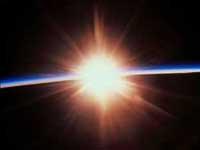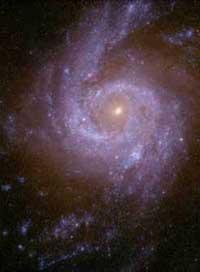Age of the universe
How many years does the universe have?
This simple and basic question has been the concern of astronomers throughout the centuries. For the calculation of age, many methods are often used, such as the measurement of the distance velocity of the universe or of white dwarfs, the weak stars that are dying, the clarity. However, these methods do not provide a correct calculation of age (they estimate that it can reach 9-16 billion years), since they are all based on assumptions about the object studied.
Radioactive cosmotiming, a method based on the amount of radioactive thorium in stars, is more reliable. Now, the team of the astronomer Cayrel of the Parisian observatory has announced a new step: In a very old star called CS31082-001 radioactive uranium has been found.
Where do the radioactive elements come from?

Almost all chemical elements have been produced in nuclear fusion reactions, hot and dense hearts of stars or supernovae. The cycles of fusion release energy, which gives the stars the pressure towards the exterior necessary to stabilize the force towards the interior of the gravitation. Although initially the nucleus is formed by elements of low atomic weight, such as hydrogen and helium, over time elements are formed heavier up to the iron. Consequently, the force of gravity also increases and the obtaining of energy through fusion becomes more difficult. At the end the forces of gravity cannot be balanced and the stars are involved, swallowing outer layers. Upon reaching the core, the stars explode by releasing all the energy, which is called supernova. However, although the supernova is one of the most spectacular episodes that can be seen in space, only some stars end up like this. The supernova generates many unstable neutrons and, to stabilize them, they are concentrated in a nucleus. At the same time, radioactive elements of great weight and long life, mainly thorium and uranium, are generated.
Why are thorium and uranium so important to astronomers?
The radioactive elements are disintegrating over time and each has a different and constant decay speed. This feature is used to calculate the age of ancient remains, both fossils and stars, and is the 14C method used in archaeology. In turn, the disintegration speed of these radioactive elements is known, so you can know when they were formed.
Thorium and radioactive uranium created after the end of the supernova of the experiences of a star born at the beginning of the history of our galaxy can still be around it for its long time of disintegration. The analysis of the amount in which they are found has allowed to know the date of birth of the universe and determine the date of birth. However, despite having observed old stars with radioactive thorium, it has not been so easy to see that they also had radioactive uranium.
Astronomers think the universe was born between 14 and 16 billion years ago, after measuring the thorium of ancient stars, which were supposedly born with the universe. However, this data is not as accurate as expected, since the time of thorium decay is so long that the calculated margin of error is also very large, 4 billion, which is too large for astronomers.
The last discovery

Cayrel and his team observed with a special telescope the CS31082-001 in search of old stars. The study carried out to this star has allowed us to approach much more to know the exact age of the universe. In addition to radioactive thorium, it has radioactive uranium. Taking into account the disintegration times of both and the amount in which they are, the Cayrele team believes that these elements were formed 12,5 million years ago. This calculation is more accurate than those previously made and presents a margin of error less than 3.3 billion.
Many stars born at the beginning of the history of the galaxy have numerous radioactive plaques, and at least one has radioactive uranium. As the new generation of large telescopes begins now, they expect to find more similar examples. The results of his studies will allow us to approach the exact age of the universe.
Buletina
Bidali zure helbide elektronikoa eta jaso asteroko buletina zure sarrera-ontzian











